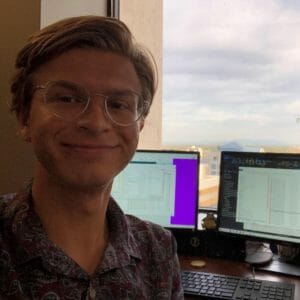Inspired by sustainability, public transit and urban spaces, School of Sustainability senior Nick Johnson took on a year-long internship with Valley Metro.
“As I continued my studies it became clear that these urban spaces are also capable of manifesting strong and environmentally responsible communities. From then on I knew that I am most passionate about working towards creating more sustainable cities that have robust transit networks, walkable spaces, and human-oriented design.”
The passion he felt has manifested in projects, student leadership and fostering a culture of sustainability, right here in the valley. Read more about Nick Johnson in his Q&A.
Sustainability Connect Question (SC): What is your role as a Valley Metro intern?
Nick Johnson (NJ): I work as a Capital Planning Intern. This means I get to work on Valley Metro’s capital projects which typically are light rail, streetcar or bus rapid transit extensions. My three biggest projects are the Fiesta District Alternatives Analysis, Capital I-10 Extension, and Tempe/Mesa Streetcar Feasibility Study. Within each of these projects, I create deliverables such as maps and PowerPoint presentations which are shared with higher-level planners, our partner cities and community members. This means most of my working days are spent working in a GIS program, doing data analysis in Excel and drafting reports based on my findings.
I’ve also contributed to smaller projects such as an ongoing light rail collisions assessment, transit-time improvement study, gentrification assessment and analysis of the 2019 Origin and Destination Survey. Through these, I’ve had great opportunities to share important findings with leadership and city partners to better inform their planning decisions.
SC: Can you tell us a little bit about your background and your passions in sustainability?
NJ: When I started at Arizona State University, I had only this vague sense that I wanted to do something in my career to combat the effects of climate change. My first few semesters were spent exploring the different ways I could apply the core concepts of sustainability in a career. Around this time, I decided to read a book titled “The Death and Life of Great American Cities” by Jane Jacobs. While reading her book my understanding of what cities were and what they could be dramatically changed. Jacobs’ descriptions of the vibrant urban spaces of New York captured my imagination and sparked my fascination with vibrant urban spaces.
As I continued my studies it became clear that these urban spaces also are capable of manifesting strong and environmentally responsible communities. From then on I knew that I am most passionate about working towards creating more sustainable cities that have robust transit networks, walkable spaces and human-oriented design. Though most importantly, these spaces must be inclusive of all members of our communities and not just wealthy, white and well-educated professionals. Within our cities, there is immense potential to advance environmental stewardship through city building.
SC: Can you talk about the intersection of urban planning and sustainability?
NJ: The professions of Urban Planning and Sustainability are directly related and both reliant on one another. Environmental stewardship can be accomplished through what I have enjoyed about urban planning, and particularly alternative transit planning, is that equity and environmental stewardship can be accomplished through the same work.
Specifically, alternative transportation planning can begin to combat current climate change trends. 28.9% of all greenhouse gas emissions in the United States come from our transportation sector. Much of this is from the American cultural obsession with personal vehicles. By investing in alternative forms of transportation and making these modes competitive with personal vehicles, the emissions from the transportation sector would drastically reduce. This is without even taking into consideration the positive externalities of dense transit-oriented development on social, political, and ecological systems. Within just this one field of urban planning, you can see how much potential there is to create a more sustainable world.
SC: What makes a good urban planner? What determines good urban planning?
NJ: Urban planning involves dealing with complex systems and relationships between governance, social structures, and the built environment. To be an effective planner, you must at least understand how these systems interrelate in the context of whatever city or urban space you are planning for. It is also incredibly important to understand the historical context of the spaces you plan for. Being mindful of the history of racism and classism perpetuated by planning practices (i.e. Redlining, Urban Renewal, etc.), it is necessary to ensure we work towards equitable cities.
Good urban planning involves working with local communities to create plans which further their ability to be socially and economically successful while minimizing their impact on the environment. Great planners must know the urban ecosystems they are working with as well as those who have lived there their entire lives. It is imperative that planners spend time in the spaces they plan for and actively engage with the local communities.
SC: How can we create more sustainable cities that are transit-oriented, walkable, and focused on the people?
NJ: This is a complex question; though from my point of view, we must eliminate subsidies for suburban development and private automobiles. Then invest those savings in alternative transportation, dense affordable housing, and community development. With an investment of this scale, we would see a complete revitalization of dense urban spaces throughout America. Though they must be revitalized as places for everyday people to live. This means creating in these spaces a variety of affordable housing types as well as accessible transit services, employment centers, grocery stores and other commercial development that serve everyday needs. To anyone reading this I would encourage you to take a few small steps to advocate for more sustainable cities. These include:
1. Begin to be critical of the urban spaces you live and work in. Consider how you would interact with these places from a variety of different perspectives. Ask yourself is this space accessible? Does it encourage me to stay? Do I see different types of people here? Am I safe in this space? How does this development impact surrounding ecosystems? Etc.
2. Use your votes, social capital and time to help elect politicians and city officials who will advocate for sustainable urban development. Support policies that improve transit, green space, affordable housing, density, and other essential urban infrastructure.
3. Try to reassess your preconceived notions of what a city should look like and who it should be for. Consider those parts of cities you love the most and what makes them great.
4. Get involved with public planning meetings or submit comments on plans if possible.
SC: What are your biggest learning outcomes?
NJ: The biggest learning outcomes thus far have been learning to apply my sustainability and urban planning education in a real-world environment. I have gained a much stronger perspective on how to convey plans and narratives to city officials and their communities. Gaining experience with technical programs such as ArcGIS and the Microsoft Suite has given me some powerful skills for engaging in the planning process. All the lessons I’ve learned from my time at Valley Metro have prepared me to become a better transportation planner.
SC: What are your plans after graduation?
NJ: I am planning on attending graduate school to continue studying alternative transportation planning and policymaking. I am currently waiting for funding information from several schools before making my final decision. Long-term, I hope to work for a transit agency or a private consultant to plan for improved alternative transportation modes.

